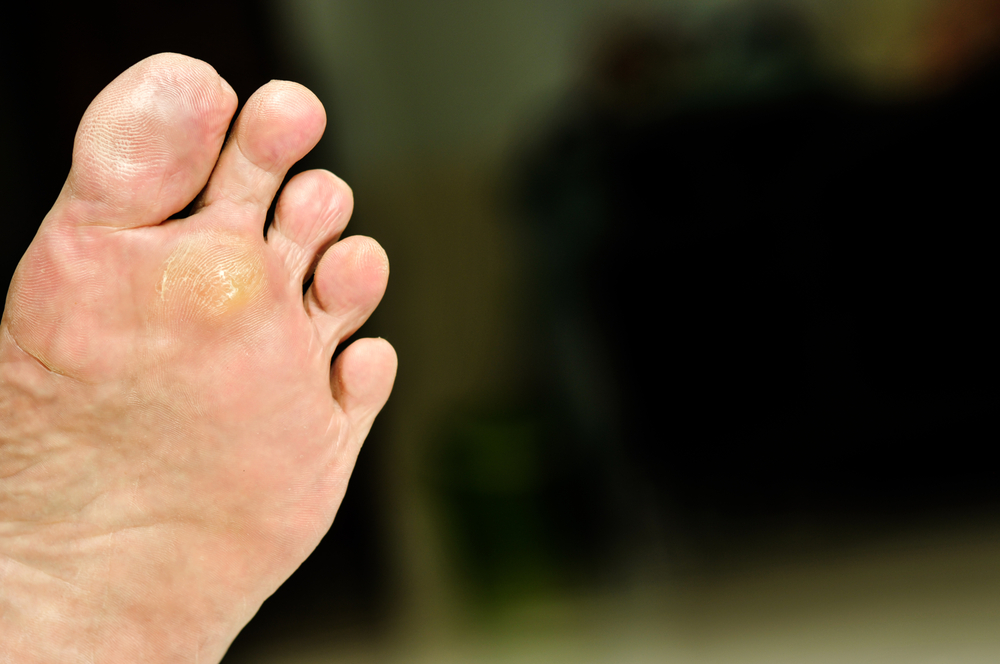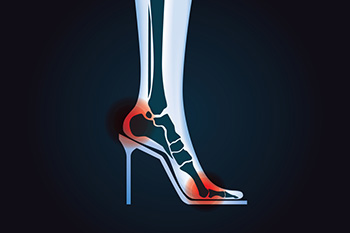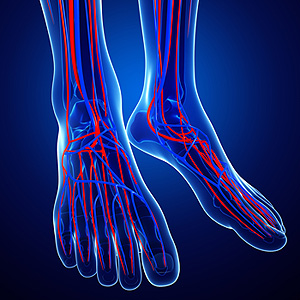Items filtered by date: March 2023
What Is a Verruca?

A verruca is a wart that appears on the feet. Such warts have tiny black dots under hard skin. While warts are generally harmless, some cause itchiness and pain. Depending on one’s personality, a person with a verruca might also experience embarrassment. A verruca or foot wart is caused by a virus, and it can therefore be contagious through contaminated surfaces or skin contact. It is important to keep the feet dry, wear foot coverings in public places, and not pick or scratch a foot wart. A verruca can be frozen off the foot, and though it may take a few sessions, this treatment should cause the wart to fall off. If you have a verruca, it is suggested that you contact a podiatrist for a proper diagnosis and treatment.
Plantar warts can be very uncomfortable. If you need your feet checked, contact Dr. Richard T. Bauer from Summit Foot & Ankle. Our doctor will assist you with all of your foot and ankle needs.
About Plantar Warts
Plantar warts are the result of HPV, or human papillomavirus, getting into open wounds on the feet. They are mostly found on the heels or balls of the feet.
While plantar warts are generally harmless, those experiencing excessive pain or those suffering from diabetes or a compromised immune system require immediate medical care. Plantar warts are easily diagnosed, usually through scraping off a bit of rough skin or by getting a biopsy.
Symptoms
- Lesions on the bottom of your feet, usually rough and grainy
- Hard or thick callused spots
- Wart seeds, which are small clotted blood vessels that look like little black spots
- Pain, discomfort, or tenderness of your feet when walking or standing
Treatment
- Freezing
- Electric tool removal
- Laser Treatment
- Topical Creams (prescription only)
- Over-the-counter medications
To help prevent developing plantar warts, avoid walking barefoot over abrasive surfaces that can cause cuts or wounds for HPV to get into. Avoiding direct contact with other warts, as well as not picking or rubbing existing warts, can help prevent the further spread of plantar warts. However, if you think you have developed plantar warts, speak to your podiatrist. He or she can diagnose the warts on your feet and recommend the appropriate treatment options.
If you have any questions please feel free to contact our office located in Latham, NY . We offer the newest diagnostic and treatment technologies for all your foot and ankle needs.
It's Time for Beautiful Feet
Foot Pain in Women Linked to High Heels

You may look great in those high heels or strappy sandals, but studies show that women who wear these types of shoes are at much higher risk of future heel and ankle pain. When you take a step, the foot absorbs a certain amount of shock from your body’s weight. Sneakers and other types of athletic shoes contain enough cushioning to handle the shock and protect the foot. However, this is generally not the case with women’s shoes, and for this reason women report heel and ankle pain in far larger numbers than do men. In fact, more than 60 percent of women who report hind foot pain have worn high heels and pumps at some point in their lives. Therefore, it is believed that past wearing of this type of shoe is a key factor in developing foot pain later in life. If you are having heel and ankle pain, it is suggested that you consult a podiatrist for guidance on proper footwear and other treatment options.
High heels have a history of causing foot and ankle problems. If you have any concerns about your feet or ankles, contact Dr. Richard T. Bauer from Summit Foot & Ankle. Our doctor can provide the care you need to keep you pain-free and on your feet.
Effects of High Heels on the Feet
High heels are popular shoes among women because of their many styles and societal appeal. Despite this, high heels can still cause many health problems if worn too frequently.
Which Parts of My Body Will Be Affected by High Heels?
- Ankle Joints
- Achilles Tendon – May shorten and stiffen with prolonged wear
- Balls of the Feet
- Knees – Heels cause the knees to bend constantly, creating stress on them
- Back – They decrease the spine’s ability to absorb shock, which may lead to back pain. The vertebrae of the lower back may compress.
What Kinds of Foot Problems Can Develop from Wearing High Heels?
- Corns
- Calluses
- Hammertoe
- Bunions
- Morton’s Neuroma
- Plantar Fasciitis
How Can I Still Wear High Heels and Maintain Foot Health?
If you want to wear high heeled shoes, make sure that you are not wearing them every day, as this will help prevent long term physical problems. Try wearing thicker heels as opposed to stilettos to distribute weight more evenly across the feet. Always make sure you are wearing the proper shoes for the right occasion, such as sneakers for exercising. If you walk to work, try carrying your heels with you and changing into them once you arrive at work. Adding inserts to your heels can help cushion your feet and absorb shock. Full foot inserts or metatarsal pads are available.
If you have any questions please feel free to contact our office located in Latham, NY . We offer the newest diagnostic and treatment technologies for all your foot and ankle needs.
Why Do I Have A Heel Spur?

Heel spurs can be painful. They are defined as bony growths that develop on the underside of the heel and can measure up to one inch. Heel spurs can be caused by inflammation and tension in the plantar fascia from standing on hard surfaces for most of the day. They may also occur from wearing shoes that have limited cushioning in the heel area, or from a foot injury. Some people have a bone deformity or muscle imbalance, which may also lead to the development of a heel spur. A common symptom that many patients experience is heel pain that is worse in the morning and may slightly subside as the day progresses. Mild relief may be found when supportive shoes are worn. If you have a heel spur, it is strongly suggested that you consult with a podiatrist who can provide you with the best treatment options.
Heel spurs can be incredibly painful and sometimes may make you unable to participate in physical activities. To get medical care for your heel spurs, contact Dr. Richard T. Bauer from Summit Foot & Ankle. Our doctor will do everything possible to treat your condition.
Heels Spurs
Heel spurs are formed by calcium deposits on the back of the foot where the heel is. This can also be caused by small fragments of bone breaking off one section of the foot, attaching onto the back of the foot. Heel spurs can also be bone growth on the back of the foot and may grow in the direction of the arch of the foot.
Older individuals usually suffer from heel spurs and pain sometimes intensifies with age. One of the main condition's spurs are related to is plantar fasciitis.
Pain
The pain associated with spurs is often because of weight placed on the feet. When someone is walking, their entire weight is concentrated on the feet. Bone spurs then have the tendency to affect other bones and tissues around the foot. As the pain continues, the feet will become tender and sensitive over time.
Treatments
There are many ways to treat heel spurs. If one is suffering from heel spurs in conjunction with pain, there are several methods for healing. Medication, surgery, and herbal care are some options.
If you have any questions feel free to contact our office located in Latham, NY . We offer the latest in diagnostic and treatment technology to meet your needs.
Symptoms of Poor Circulation

Common symptoms of poor circulation can include cold feet, a loss of feeling in the fingers and feet, and the skin may become discolored. When circulation is normal, the blood, oxygen and nutrients are transported freely through the blood vessels. Patients who have poor circulation have blood vessels that have become closed or hardened, causing the blood to move slower through these vessels. Additional symptoms of reduced or poor circulation can consist of weakened toenails, cracked skin, and existing wounds may heal slowly. This ailment can be indicative of underlying conditions. People who have Raynaud’s disease have limited blood flow to their extremities, which may be triggered by stress. Elevated glucose levels in diabetic patients may cause the arteries to narrow and blood vessels to become damaged, possibly leading to poor circulation. If you have any of these conditions, including a numbing sensation in your feet, it is suggested that you speak with a podiatrist who can effectively diagnose and treat poor circulation.
While poor circulation itself isn’t a condition; it is a symptom of another underlying health condition you may have. If you have any concerns with poor circulation in your feet contact Dr. Richard T. Bauer of Summit Foot & Ankle. Our doctor will treat your foot and ankle needs.
Poor Circulation in the Feet
Peripheral artery disease (PAD) can potentially lead to poor circulation in the lower extremities. PAD is a condition that causes the blood vessels and arteries to narrow. In a linked condition called atherosclerosis, the arteries stiffen up due to a buildup of plaque in the arteries and blood vessels. These two conditions can cause a decrease in the amount of blood that flows to your extremities, therefore resulting in pain.
Symptoms
Some of the most common symptoms of poor circulation are:
- Numbness
- Tingling
- Throbbing or stinging pain in limbs
- Pain
- Muscle Cramps
Treatment for poor circulation often depends on the underlying condition that causes it. Methods for treatment may include insulin for diabetes, special exercise programs, surgery for varicose veins, or compression socks for swollen legs.
As always, see a podiatrist as he or she will assist in finding a regimen that suits you. A podiatrist can also prescribe you any needed medication.
If you have any questions, please feel free to contact our office located in Latham, NY . We offer the newest diagnostic and treatment technologies for all your foot care needs.

